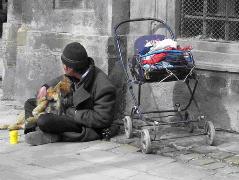Analytics, Financial Services, Latvia, Society
International Internet Magazine. Baltic States news & analytics
Wednesday, 14.05.2025, 05:18
Economic crisis still makes all society in Latvia less wealthy
 Print version
Print version |
|---|
The dependence of the Latvia population upon the social tranfers has increased. In 2009 28% of the income volume were formed by the social transfers, while in 2010 the number constituted already 31%. At-risk-of-poverty rate, if calculated excluding all kinds of social expenditure, would reach 46% in 2010, and it is the highest indicator since 2004.
Employment forms a stabile basis for the family material welfare. The at-risk-of-poverty of employed in 2010 has diminished, whereas the unemployed persons have to face its growth. It should be noted that in 2010 the total number of employed persons (on average per year) reduced, while the number of unemployed persons increased. The at-risk-of-poverty of unemployed persons has risen from 48% in 2009 to 50% in 2010, however the number is smaller than during the pre-crisis years. For the persons working full-time the at-risk-of-poverty has reduced from 8.2% to 7.8%, but for the persons working part-time on the opposite – it has grown from 23% in 2009 to 25% in 2010. At-risk-of-poverty for the part-time employees in 2010 actually was the same as one for the persons not at work (26%).
High at-risk-of-poverty among various population age groups in 2010 was recorded for children aged under 17 (25%). Whereas noticeably higher at-risk-of-poverty was observed for households of one adult and children (39%), as well as for households consisting of 2 adults with 3 and more dependant children (37%).
The difference between the actual income of persons at-risk-of-poverty and at-risk-of-poverty rate (relative median at-risk-of-poverty gap) in 2010 has grown. It has increased from 29% (under the at-risk-of-poverty threshold) in 2008 and 2009 to 32% in 2010, showing that the depth of poverty in these households has grown.
At-risk-of-poverty threshold and at-risk-of-poverty rate derived from it are relative indicators, depending on the average income level in households. The data of the EU-SILC survey show significant changes in the volume and structure of household disposable income. In 2010 household disposable income, calculating per one household member, comprised LVL 201, and it is 5.9% or LVL 13 less than in 2009. Along with the reduction of the overall income level in the country also the at-risk-of-poverty threshold in 2010 has decreased already for the second year in a row. In 2010 it comprised LVL 149 per month for the single person households (in 2009 – LVL 160, in 2008 – LVL 192).
Data source of the monetary poverty and social inequality indicators is the EU-SILC survey. In the survey of 2011 6.6 thousand households were surveyed and 13.5 thousand respondents aged 16 years and over were interviewed. Data on income were compiled on 2010.
Methodological explanations
At-risk-of-poverty rate- share of persons with an equivalised disposable income below 60% of the national median equivalised disposable income. Equalised disposable income is a household disposable income divided by its „equivalent size” which is calculated with the help of the so-called „modified OECD” equivalence scale. This scale gives a weight of 1.0 to the first adult, 0.5 to any other household member aged 14 years and over and 0.3 to each child aged less than 14 years.
At-risk-of-poverty threshold- 60% of the national median equivalised disposable income. Median of a finite list of numbers can be found by arranging all the observations from lowest value to highest value and picking the middle on.
Disposable income- cash income from labour, employee income in kind received by using company car for private needs estimated in cash, income or losses received from self-employment, received pensions and benefits, regular material assistance from other households, profit from interests of deposits, dividends, shares, income received by children aged under 16 years, income from property rental, receipts for tax adjustments from State Revenue Service (for business activities, eligible costs-education, medical treatment etc.). From this total amount of income the following are deducted: real estate tax, amount of money regularly given to other households, amount paid to State Revenue Service due to unpaid or insufficiently paid income tax.
Social transfers – pensions and benefits paid by the State or municipality, child maintenance payments, scholarships, social insurance benefits and compensations, including the ones paid by other countries.
Relative median at-risk-of-poverty gap-percentage difference between the at-risk-of-poverty threshold and median equivalent disposable income of persons below the same threshold.








 «The Baltic Course» Is Sold and Stays in Business!
«The Baltic Course» Is Sold and Stays in Business!

